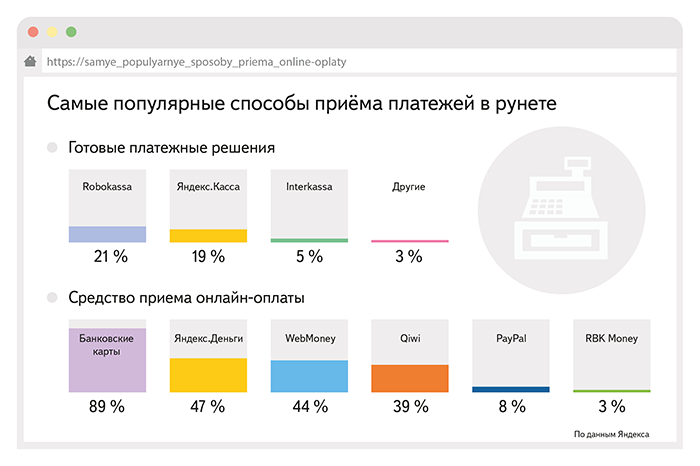Online stores teach buyers to pay online

A few years ago, Russian buyers of online stores most often paid for the goods upon receipt, rather than online. Most users stated that they do not trust stores and online payment systems. Now the situation is gradually changing, and the share of Internet payments is growing every year. Yandex found out what payment options are offered by online stores, and Data Insight conducted a survey of Runet’s customer preferences.
Store Offers
')
At the end of May, Yandex published a study on how to accept online payments in Russian online stores. Experts analyzed 86 thousand sites that have the opportunity to pay for purchases online.
More than half of online stores offer various payment methods - from three and more. The share of such sites has increased significantly over the year. But 46 percent still have only one option for accepting payments online.
Almost all sites offer payment by bank cards - 89 percent. Almost half accept funds through the Yandex.Money and WebMoney payment systems, 39 percent through Qiwi, eight through PayPal, and three percent through RBK Money.
It turned out that about half of the Internet resources do not develop their own payment solutions, but use ready-made services, such as Robokassa and Yandex.Kassa. With the help of Robokassa, 21 percent of online stores accept money, through Yandex. Cashier - 19 percent. Another five percent of sites use Interkassa, less than three percent choose other payment solutions - Wallet One, Oplata, PayOnline, PayAnyWay.
But so far, not all Russian online stores accept payments online. Even in Moscow, the share of sites where you can only select and order goods, but cannot pay, is 20 percent, according to a study by the Department of Information Technology.
At the same time, 90 percent of Moscow online stores have self-pickup. This is a feature of Russian online retail, since in Europe goods are most often delivered by postal or courier services, and stores only accept payment online.
User preferences
For 28 percent of buyers, it is important that the online store has different options for paying for the order, according to a Data Insight study. 33 percent admit that if the payment cannot be made online, they can forget about the order.
But more than half of the orders buyers still pay in cash when they receive the goods. A quarter - by credit card on the site, 10 percent - through electronic payment systems, and six percent - by credit card upon receipt.
Previously, the share of those who pay for purchases online was even lower. For example, in the largest Russian online store Ozon, the share of prepaid goods among all orders increased from 9.5 to 21 percent over three years.
According to PwC, back in 2012, about 43 percent of respondents to the question "Why do not you buy goods via the Internet?" Answered: "I do not trust online payment methods." In 2013, the figure was 38 percent. Now, according to Data Insight, there is no such problem. Beginner Internet users are more likely to refuse online payments because of incomprehensible and complex interfaces than due to lack of confidence.
According to Ozon's press secretaries, Maria Nazamutdinova, the service, along with payment operators, conducted special promotions that encourage you to pay for purchases online. For example, provided free shipping for prepaid orders.
Experts also attribute the increase in the share of non-cash payments to the increase in the popularity of purchases in foreign online stores, especially in Chinese Aliexpress. The share of buyers of foreign online stores increased from 18 to 31 percent over the year.
How exactly pay and get
Most users - 87 percent - pay for the order online using a debit card, three quarters - through online banking. 64 percent use electronic money, about half use mobile banking and SMS payments, and 46 percent use credit cards. In 2014, the segment of electronic money (one and a half times) and mobile banking grew the most (by 39 percent).
Most often, buyers receive goods by mail (41 percent). Almost a third choose courier services, 20 percent - points issuing orders online store. Six percent take away the goods in the offline store branch, and two percent - in the points of delivery of courier services. Post offices (automatic points for issuing orders) are not very common in Russia - they account for only one percent of orders.
It is worth noting that in smaller cities, online shoppers are more likely to receive goods by mail. Residents of Moscow prefer courier delivery, and St. Petersburg - pickup.
Source: https://habr.com/ru/post/291428/
All Articles